Judith A. Yates's Blog, page 3
August 10, 2020
We overlook a vital lesson in Daisy Coleman's suicide
On August 4, 2020, Daisy Coleman, an activist against sexual violence, subject of a documentary on sexual violence against female teens, and rape survivor, committed suicide on August 4, 2020. The media immediately began reporting statistics on sexual assault rates of females and contact numbers for suicide prevention organizations. We overlook a vital lesson in Daisy Coleman’s suicide: the importance of educating men and boys on sexual assault. Again, another sign of “proactive rather than reactive” in response to crime and focusing on the wrong people.
In the current news, education on date rape and sexual assault appear to focus on teaching young women how to protect themselves: “no” means no, the correlation between alcohol and drug consumption and sexual assault, and self-defense mechanisms. What also should be addressed is teaching our young men, in time-tested vernacular, “how to be a gentleman.” Including: “no” means no, the correlation between alcohol and drug consumption and sexual assault, peer pressure dynamics, and the definition of “a man.”

Approximately 1 in 5 American women have reported completed or attempted rape at some point in their lifetime; Approximately 1 in 6 women experienced sexual coercion - e.g., being “worn down” or “forced” to say “yes” to a sexual act (CDC). In 2018, the self-reported incidence of rape or sexual assault more than doubled (Morgan).
An older but revealing study from 2014 reports, “31.7 percent of college males ... in a study at the University of North Dakota said they would act on ‘intentions to force a woman to sexual intercourse’ if they were confident they could get away with it.” However, “When asked whether they would act on ‘intentions to rape a woman’ with the same assurances they wouldn’t face the consequences, just 13.6 percent of participants agreed” (Morgan, cited in Culp-Ressler). The researchers concluded the respondents did not equate the word “rape” and “force(d) sexual intercourse.” And Dr. Sherry L. Hamby editor of the journal Psychology of Violence, says of incarcerated rapists, “No one thinks they are a bad guy,” including inmates who have abducted and kept women as sex slaves. There is a disconnection of the perpetrator from the victim and “victim-blaming/shaming.” And “experts note one last trait shared by men who have raped: they do not believe they are the problem.”
In studies on sexual assault, researchers have discovered other commonalities in rapists include:
They usually deny that they have raped women even as they admit to nonconsensual sex.
The men begin early, high school, or first years in college, raping an acquaintance.
They may associate with others who also commit sexual violence.
Repeat offenders feel rejected, or they feel as if they are not in a favored group, such as the high school football players. As these males become more successful (e.g., a “college man”) the sexual assault is a revenge tactic (cited in Murphy).
Another dated but revealing study of high school boys shows 60% “found it acceptable in one of more situations for a boy to force sex on a girl.” One out of five students reported they had experienced forced sex; only half of them told someone about the assault (Davis).
Thus far, historically, prevention and awareness of sexual assault have been made a “girl’s problem” – teaching the female to protect herself, media attention focusing on the female, the victim-survivor creates the nonprofit organization to raise awareness – usually because of victimization. (Daisy Coleman co-founded SafeBAE, an organization working to raise awareness about sexual assault in middle and high schools.)
Daisy Coleman was 14 on January 8, 2012, when, after a night of drinking, she became unconscious, and Matthew Barnett, her brother’s friend, raped her. Barnett’s friend Jordan Zech recorded the rape on his cellphone. Barnett then dumped Daisy on the Coleman front steps in freezing temperatures, where her mother found her the next morning. The incident occurred in her hometown of Maryville, Missouri. Barnett, 17, charged with felony assault, argued the sex was consensual. Nodaway County’s Prosecuting Attorney stated there was insufficient evidence, and Barnett eventually received two years probation plus a $1,800 fine. (Many believed this light sentence was the result of Barnett being the grandson of Missouri Republican Representative Rex Barnett.) Daisy and her family were ostracized from their community: their house mysteriously burned down, Mrs. Coleman’s employer fired her, and Daisy relentlessly bullied and harassed. A documentary, “Audrie & Daisy” was made of the case, and included 15-year-old Audrie Pott’s story, which was similar. Maryville sheriff Darren White is interviewed in the film saying of Daisy’s case, “Girls have as much culpability” in rape cases.
If society does not start educating young men and boys on how to treat a woman – even the most basic “common respect” – then we are treating our victims with disrespect, a “second rape.” We are creating adult males who believe nonconsensual sex is not rape, and that girls are to blame. We overlook a vital lesson in Daisy Coleman's suicide.
Audrie committed suicide nine days after she was gang-raped, then bullied. Nine years after her rape, Daisy Coleman’s many demons caught up with her, and she placed a loaded pistol to her pretty head and squeezed the trigger. Each of them ended their “girl’s problem.”
CLICK HERE for information on sexual violence resources and education
Resources
Bradshaw, K.A.; Edwards, S.R.; & Hinz, V.B. (December 15, 2014). Denying Rape but Endorsing Forceful Intercourse: Exploring Differences Among Responders. Violence & Gender. Vol. 1, No. 4. https://doi.org/10.1089/vio.2014.0022Center for Disease Control & Prevention, cited in National Sexual Violence Resources Center (NSVRC) 2015 Data Brief,https://www.nsvrc.org/statistics
Culp-Ressler, T. (January 11, 2015). 1 In 3 College Men In Survey Say They Would Rape A Woman If They Could Get Away With It. ThinkProgress. https://archive.thinkprogress.org/1-in-3-college-men-in-survey-say-they-would-rape-a-woman-if-they-could-get-away-with-it-ffa7406b9778/Davis, T.C.; Peck, G. Q.; Storment, J.M. (May 1993). Acquaintance rape and the high school student. Journal of Adolescent Health. Vol. 14, Issue 3. (pp. 2220-224).Morgan, R.E. & Oudekerk, B.A. (September 2019). Criminal Victimization, 2018. U.S. Department of Justice Office of Justice Programs Bulletin. https://www.bjs.gov/content/pub/pdf/c...
Murphy, H. (October 20, 2017). What Experts Know About Men Who Rape. The New York Times. https://www.nytimes.com/2017/10/30/he...Smith, N. M. (January 30, 2016). “Audrie & Daisy Review - teenage rape documentary is essential viewing.” The Guardian. https://www.theguardian.com/film/2016...

July 20, 2020
Netflix Show ‘Exhibit A’ Profiles Innocent Convicted Killers. Oh, Really?
The Netflix series “Exhibit A’ claims to show “how innocent people have been convicted with dubious forensic techniques and tools such as touch DNA and cadaver dogs.” Cashing in on the idea that “many people in prison are innocent” theory, the series investigates crime cases that, in the eyes of the defense, the perpetrator, and the perpetrator’s friends, plant just enough seeds in the viewer’s minds that the convicted has been railroaded into prison by shoddy science. Oh, really?
One of the segments, “Blood Spatter,” tells the story of Norma Jean Clark, convicted in 2013 of the shooting death of her husband, Ed, which occurred in the early morning of April 22, 1987. The episode suggests the case was built entirely on blood spatter found on the nightgown Norma was wearing the night she “found” Ed’s dead body. Ed was lying face down in his bed, shot with his gun discovered on the nightstand beside the bed. Norma’s appeals attorney argues the blood spatter so minuscule. She also asks why no one investigated a Mr. Michael Todaro, the “original owner” of the handgun; but, Todaro has mysteriously moved out of the country. The attorney points out Todaro’s mugshot, where his mouth is agape, and he is disheveled. Norma’s best friend argues the same and says that Norma left an abusive husband in her first marriage, and “if she woulda killed somebody, it woulda been him.” Norma and her friends reveal Ed reportedly had multiple enemies due to how he conducted business as a construction supervisor. The professionals and experts in ballistics and blood spatter made to appear questionable, including Tom Bevel, probably the foremost expert in the United States in blood spatter patterns. (When investigators tell Norma “blood was found” on her nightgown, there is a pause, and then she asks, “is it Ed’s blood?”) And the Clark home had been vandalized in the past, with anonymous threatening phone calls and letters (made from newspaper lettering), all suggesting the same person had murdered Ed.
What “Blood Spatter” doesn’t reveal:
Norma said a door was open when she ran out of the house to get help on April 22, 1987. Otherwise, there were no other signs of forced entry.
The home security alarm either had not been set that night or off. This was entirely out of the ordinary as Ed always complied with setting the house alarm at night.
Norma ran to the home of the Manack family for help when she “heard something.” She had never checked on Ed or investigated the “noise.” Later she would contradict this statement multiple times. Mrs. Manack would tell police that Norma stated she had run through dark woods to arrive at the Manack home, but her feet, legs, and nightgown were clean of debris.
Norma returned to the Clark home and changed clothes. She brought the nightgown back to Mrs. Manack, asking her to wash it. Mrs. Manack did not wash it but turned it over to police, adding, “Norma’s first concern did not seem to be that Ed was dead.”

The Clarks were close to divorce. Ed was preparing to tell Norma she had days to get out. “Exhibit A” does not detail how Ed was secretly moving money into accounts, seeing someone else, how Norma grew up poor and had been left destitute from her first marriage, and how she had told friends she was not about to be left in that state again. Later, there would be bitter feuds over Ed’s estate with Norma in the fray.
On April 22, 1987, after Ed’s body was found, and while Norma was at the Manacks’, Norma telephoned her employer, a doctor. She requested that the doctor hospitalize her; “she ‘needed’ to be admitted to the hospital because the police wanted to test her hands for gunshot residue.” Norma also asked her employer for $10,000 for a defense lawyer. When the doctor advised to cooperate with police and refused to have her admitted, Norma had herself admitted for what would later appear to be a false medical claim.
The day of the murder, Norma went to the bank as soon as it opened to withdraw money.
Norma had Ed's body cremated as soon as possible, did not attend services, nor did she have any sort of services for him.
Norma refused to give a formal statement to police, refused to testify before the grand jury, continuing to provide contradictory statements to friends, law enforcement, and officials. Norma added, “she ‘didn’t feel like’ she was a suspect.”
Michael Todaro’s mug shot is frightening. This is because he was intoxicated. Extensive research proved, “Todaro had no connection to the case other than that he was the original purchaser of Ed’s gun. … The gun likely changed hands several times through legal sales before Ed bought it at a gun show or from a private seller.” No one associated with Ed knew Todaro or had ever seen him.
Norma’s angry son was a long-time suspect in the vandalism and threats. He had been kicked out of the home before these crimes.
Many of Norma’s close friends believed she had committed murder based on her actions and behavior, despite the fact they did not want to find their friend had committed a crime.
In 1987, the District Attorney felt the evidence was strong but too circumstantial to go to trial. Thus, the case sat dormant.
In 2010, the nightgown was tested, this time with forensics testing much improved since 1987. The assistant director of the lab at the Harris County Institute of Forensic Sciences and Tom Bevel both ran laborious tests.
Norma had claimed she had gone nowhere near the body, but there was blood on her nightgown. A husband’s bodily fluid on the wife’ lingerie is not proof; the blood spatter patterns were consistent with blowback patterns.
Dr. Bill Davis, an expert in the field of gunshot residue, testified there was some gunshot residue discovered on the nightgown, which was rare due to the 1987 testing and handling of the garment through time.
In 2013, Norma Jean Clark was found guilty of murdering Ed Clark and sentenced to 25 years in the Texas prison system. She currently resides in the Young Unit. According to Netflix’s “Exhibit A” she is an “innocent” woman railroaded by the justice system “convicted with dubious forensic techniques.”
The issue with these types of shows is that they will make people lose faith in the justice system, particularly in the current times. It will solidify the belief “many people in prison are innocent.” Most importantly, it will make a martyr out of guilty murderers who have left surviving victims emotionally crippled for life. Surviving victims again lose their voices while the guilty shout, “I’m innocent!” And without examining the whole story, television creates its own version.
Resources
Final Report on Complaint by The Harris County Public Defender’s Office Against the Harris County Institute of Forensic Sciences, Harris County Sheriff’s Office And Houston Police Department. (February 2, 2018). Texas Forensic Science Commission. https://www.txcourts.gov/media/144177...
Loudenberg, K. Creator. “Exhibit A.” Blood Spatter. [Netflix.]
McDaniel, K. Assistant District Attorney in Harris County (no date). A long-dormant Houston case is cracked. Texas District & County Attorney’s Association. Online journal.
https://www.tdcaa.com/journal/a-long-...N Series “Exhibit A.” (2020, July 20). Retrieved from https://www.netflix.com/title/80245117
Norma Jean Clark v. The State of Texas Appeal from 228th District Court of Harris County (memorandum opinion by Chief Justice Radack). No. 01-13-00373-CR. 228th District Court, Harris County, TX. Trial Court Case No. 1295757
The Texas Tribune (2020, July 20). Norma Jean Clark.
https://www.texastribune.org/library/...
July 2, 2020
Serial killer Roy Norris draws victim’s portrait, collector sells at high price
While I disagree with a murderabilia collector’s hobby, I respect the collector’s rights to do so. This is one of those instances where I disagree with and disrespect the hobby; this time, I find it sickening. To sell the portrait of a tortured murder victim drawn by the perpetrator, a serial killer-rapist, has crossed the line; profiting off the gristly murder of an innocent victim is a blatant, twisted display of total disregard for the surviving victims.
It is essential to know the details of the crime in order to grasp the repulsiveness of this entire story.
Lucinda “Cindy” Schaefer was walking home from her beloved church in Redondo Beach, California, in June 1979, when serial killers Lawrence Bittaker and Roy Norris abducted her. They bound her with duct tape, drove her to the mountains, and repeatedly raped her. They used a hammer to strike and torture her, pliers to remove her teeth. Lucinda pleaded for "a moment to pray" before they killed her; they laughingly denied the request. The killers attempted to strangle her. Bittaker used vise-grip pliers to twist a wire coat hanger around her throat until she was dead. They wrapped her remains in a plastic shower curtain and tossed her off a cliff, her body never recovered.
 Artwork of Cindy Schaefer by her killer,
Artwork of Cindy Schaefer by her killer, Roy Norris
That is the police report, the legal version. Then there is the version of Cindy Schaefer that few get to know.
A willowy, pretty girl, 16-year-old Cindy Schaefer had long blonde hair and a beautiful smile. Author Laura “Siren of San Quentin” Brand has dedicate years interviewing Bittaker and Norris and investigating their crimes in her effort to locate remains of the duo’s missing victims. Brand says, “Cindy’s first boyfriend has never recovered from losing her, even after over forty years. Her best friend, her family, will never recover. Cindy spoke fluent Spanish because she wanted to be like her mother, who took mission trips to Mexico teaching English.” Brand shares the dreams and hopes of this teen whose life was cut short and brutally ended by evil. “Cindy wanted to study languages and teach English in underdeveloped countries. She was a ‘good Catholic girl,’ no drugs, no drinking. Cindy played guitar, loved to write music.”
Laura Brand shares what she secretly learned in one interview with Bittaker. “When Cindy’s mom and grandmother were running around all over, trying to find Cindy (after she went missing), Norris wanted to call Cindy’s grandma and say, “I killed the bitch,’ and hang up. He wanted to specifically tell her grandmother .” Brand recalls Bittaker and Norris laughing about their victims, from the murders to their deathbeds, never expressing remorse.
Lawrence Bittaker and Roy Norris were both arrested in 1979. Bittaker received death. Norris received 45 years to life imprisonment; he would never be paroled. Both died of natural causes in 2019; they both left items that murderabilia collectors swooped down on like vultures: televisions, papers, and pictures. Somehow, one murderabilia site has obtained Roy Norris’ numerous personal effects and is selling everything from an ice cream wrapper ($49.) to hand tracings “…with both bblack [sic] and red fingerprints and portions of his hands” ($895.) among the ten screens of “Roy Norris” items. It is one of these items that has caused me to write this blog.
Roy Norris used Lucinda “Cindy” Schaefer’s “missing” poster photo – the same girl he tortured and repeatedly raped – to draw her portrait. And now this same murderabilia website is selling this portrait for $2,900.
You don’t have to personally know Cindy to shed tears at what these two men did to her. And, in my opinion, this now includes Norris’ artwork and the selling of the image. This portrait is not a homage done in penance. Roy Norris did not pick up paper and colors in self-reproach to memorialize this girl.
 Cindy SchaeferWhile Norris had the legal right to capture Cindy’s image, and the murderabilia website has the right to make a profit, somewhere we all have to consider what is ethical and moral. (I attempted to contact the owner of the murderabilia site, asking for their honest and open responses; I asked without malice, giving them a chance to explain. I received no response.)
Cindy SchaeferWhile Norris had the legal right to capture Cindy’s image, and the murderabilia website has the right to make a profit, somewhere we all have to consider what is ethical and moral. (I attempted to contact the owner of the murderabilia site, asking for their honest and open responses; I asked without malice, giving them a chance to explain. I received no response.)I have learned from a source that some collectors will ask the perpetrators to draw their victims; these drawings bring a high price and are coveted items. I do believe that items from crime scenes, locations of crime scenes are part of our history. And I damn sure believe you cross a line when you request, sell, or purchase a portrait of a victim drawn by that killer. Evidently these people have never been the victim survivors of murder, because they would know what their actions are doing to Cindy' loved ones, to Cindy's memory, her legacy.Bittaker would write of Cindy’s response just before they killed her, “I guess she knew what was coming.” Cindy Schaefer had no idea of the degree of her exploitation.
Resources
Quotes from the case come from Bosco, D. & Markman, R. M.D. (1990). Alone With The Devil. New York: Bantam Books.
Quotes from the murderabilia website come from the same webpage where the drawing is sold and will remain anonymous in respect to Cindy and her loved ones.
June 24, 2020
Then, what is a “Hate Crime”?
Investigator A is interviewing a scruffy suspect, named Marvin, in interview room number five. “So, you and your friend, Roger, attacked and robbed the man at the gas station. Why?”
Marvin replies, “Because he was a nigger. Niggers are all dope dealers, pimps, drive flashy cars, so I knew he had money.”
Simultaneously, in interview room number two, Investigator B interviews a disheveled Roger, whose T-shirt reads “Southern White Pride,” decorated with a rebel flag. “Why did you and Marvin attack and rob this particular man?”
“He had a nice car. I figured he was a dope dealer, had money.” He is asked again and says, that is the sole reason he selected the victim.
Marvin has committed a hate crime. Roger has not. What is the difference?
The hate crime law might seem easy to define, but it is a finely sharpened double-edged sword. To understand it is helpful to explain the history.
In 1968, the first federal hate crime bill was signed into law, enforced by the Department of Justice. This statute made it illegal, in part, “to use or threaten to use, force to willfully interfere with any person because of race, color, religion, or national origin” should the person participate in “a federally protected activity” including public education.
“If you don’t drop out of this school, my boys will make sure you won’t see tomorrow, kike!”
“If you don’t drop out of this school, my boys will make sure you won’t see tomorrow!”
Initially, there are apparent differences in the above threats. But taking a closer look (the obligations of the defense attorney, courts of law, and investigative teams), what is the intent behind the threat? Does it mean the “threat of death or harm”? Does it mean the “boys” will take some nonviolent preventative measures, such as a formal complaint based on a lie? (i.e., “I saw him cheating on a test.”) The derogatory slur added to the first threat may be perceived as part of the “threat” - or just name-calling.
“If you don’t drop out of this school, my boys will make sure you won’t see tomorrow because we hate kikes!” is illegal by the 1968 federal hate crime bill standards. Can it be challenged? Anything can be challenged.
The same year, Congress passed the Criminal Interference with Right to Fair Housing Act, which meant people could not be denied housing because of their “race, color, religion, sex, or national origin.” (note sexual orientation or identification has yet to be identified in any statute thus far.) Again, this crime relies on proof: “use, or threaten to use, force to interfere with.” If a Hispanic family feels a landlord was refused them rental housing based on race, they must prove it – not an easy thing to do without the renter’s voicing the fact.
In 1996, the Church Arson Prevention Act was signed, i.e., to deface a synagogue or a “black church” was illegal, but only if proven that the arsonist’s intent was to “interfere with a person’s religious practice.” Law enforcement officers became trained in this hate crime, and the statue relied on these interviewing officers to prove this hate crime. If the offender says, for example, “I burned it to the ground because I hate Catholics” it can be classified as a hate crime. It is the officer’s duty to note it in the report, as with all reports; we rely on the officer’s training and dedication to do so.
In 2009 The Matthew Shepard and James Byrd Jr. Hate Crimes Prevention Act was signed into law. 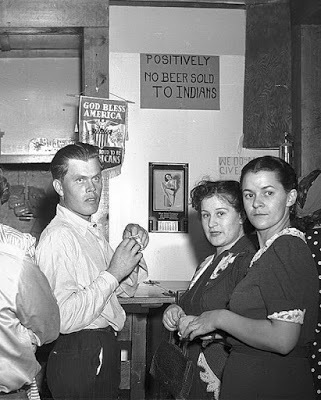 Sign posted above a bar in Birney, MO,
Sign posted above a bar in Birney, MO,
1941, refusing service to "Indians."“(A) federal crime to willfully cause bodily injury, or attempt to do so using a dangerous weapon, because of the victim’s actual or perceived race, color, religion, or national origin … actual or perceived religion, national origin, gender, sexual orientation, gender identity, or disability of any person, only where the crime affected interstate or foreign commerce or occurred within federal special maritime and territorial jurisdiction.” Again, the perpetrator must voice, or somehow proof must be shown, of discrimination, and "only where." (italics author)
What do all of these Acts have in common? Intent. Proof in a court of law that the crime committed “to willfully interfere…to interfere with…willfully cause…” The burden of proof rests with the State’s office. A court relies on the language of the law, not emotion. The public can be outraged and sickened by discrimination (or perceived discrimination), but a court of law must follow the statutes: Was there “interference”? Did the act “willfully cause”? Did the perpetrator display proof of intent? Did the actions meet all criteria?
In the above example, Marvin expresses disdain for black people, which is why he selected his victim. Roger says he chose the victim because he believed the victim to be wealthy; he does not mention race despite harboring the same perceptions as Marvin. To the public, both men will be perpetrators of a hate crime. To the courts, Marvin will be charged. And this is one reason why hate crimes can cause such heartache, confusion, and disdain. The double-edged sword cuts deep.
Resources
National Archives. The Bill of Rights. https://www.archives.gov/founding-doc...
The United States Department of Justice. (March 7, 2019). Hate Crime Laws.
https://www.justice.gov/crt/hate-crim...
United States Courts. What Does Free Speech Mean? https://www.uscourts.gov/about-federal-courts/educational-resources/about-educational-outreach/activity-resources/what-does)
Photo:
By Marion Post Wolcott - FSA photo by Marion Post Wolcott.LOC [1]LC-USF34-58491-D, Public Domain, https://commons.wikimedia.org/w/index...
Please subscribe to my new video series, “Best True Crime” – A new way to see unusual crimes, unsolved, cold cases, and infamous locations! Go here:
June 11, 2020
A Purse And A Protest: How One Word Can Lead To Murder
 Continuing with the scenario: pulled apart now, Pat and I have suffered blows to our ego that have gone unresolved. I struck a nerve in Pat’s childhood history, or something deeper, something that pierced Pat’s soul: prejudice, self-esteem, old anger that just needed a nudge to awaken. And I would have been angered, embarrassed that I was called out in front of my peers, unnecessarily cursed, and upset that someone I believed an ally has so quickly turned against me. Something in Pat’s quick, hateful retort against my core value would have hurt me, and I could not forgive or forget.Cocktails were available at this gathering; had Pat and I been drinking, our senses and judgments would have been skewered. No illegal drugs were involved. Had this been a factor, the scenario would have different consequences.Pat and I are mature adults, and both have had to grow up quickly because of our upbringing. We are no longer youthful, thinking life will last forever, and there are no consequences to our actions. Sure, we can be irrational and make dumb decisions like all humans do; it’s just not our norm.But, had all these factors not come into play, the end of this story would have ended in tragedy. Had Pat and I been emotionally immature, under the influence, began a verbal argument, turned it physical, and then walked away from one another with feelings left smoldering, I would have felt unjustified. I would have felt as if Pat failed to hear me out and judged me without trying, embarrassing me in front of my peers to make me look stupid and small. To avenge myself and keep my dignity - winning this argument - I could have gone to my purse to retrieve my gun, returned to Pat, and ended it forever. This is an example of how a peaceful protest turns into a riot. First, a crowd is trying to explain themselves, their belief. A second party – a person, a group, an
Continuing with the scenario: pulled apart now, Pat and I have suffered blows to our ego that have gone unresolved. I struck a nerve in Pat’s childhood history, or something deeper, something that pierced Pat’s soul: prejudice, self-esteem, old anger that just needed a nudge to awaken. And I would have been angered, embarrassed that I was called out in front of my peers, unnecessarily cursed, and upset that someone I believed an ally has so quickly turned against me. Something in Pat’s quick, hateful retort against my core value would have hurt me, and I could not forgive or forget.Cocktails were available at this gathering; had Pat and I been drinking, our senses and judgments would have been skewered. No illegal drugs were involved. Had this been a factor, the scenario would have different consequences.Pat and I are mature adults, and both have had to grow up quickly because of our upbringing. We are no longer youthful, thinking life will last forever, and there are no consequences to our actions. Sure, we can be irrational and make dumb decisions like all humans do; it’s just not our norm.But, had all these factors not come into play, the end of this story would have ended in tragedy. Had Pat and I been emotionally immature, under the influence, began a verbal argument, turned it physical, and then walked away from one another with feelings left smoldering, I would have felt unjustified. I would have felt as if Pat failed to hear me out and judged me without trying, embarrassing me in front of my peers to make me look stupid and small. To avenge myself and keep my dignity - winning this argument - I could have gone to my purse to retrieve my gun, returned to Pat, and ended it forever. This is an example of how a peaceful protest turns into a riot. First, a crowd is trying to explain themselves, their belief. A second party – a person, a group, an
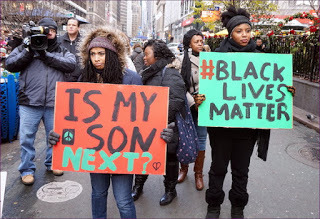 organization – either does not or appears not to be, listening; this party doesn’t seem to care. When words fail, we animals act. Strangers in neutral territory, banding together for the same cause, are more likely to follow one another. Should anyone in the crowd be emotionally immature, under the influence, the escalation to violence will be faster. The people in this crowd have suffered blows to their ego that have gone unchecked: childhood trauma, anger, hurt, any feeling they need to express that has been sleeping. Like a tea kettle, the pressure has been building; all it needs is action to set it off. Maybe someone throws a bottle or a firecracker, or a police officer pushes a protester. There is a high potential for the initial disagreement to turn deadly. Of course, I did not fetch my purse to shoot Pat at the party. And I did explain my religious values to Pat and the others, who respected my feelings. Later, we would laugh about it. We all eventually left the party promising to meet up again soon, safe and happy.Currently, our city streets are teeming with people who need to be heard and explain. There are both protesters and rioters. Some of my readers understand why these people are doing what they do. Other readers are angry and hurt at their actions. One fact we all understand: people have lost their lives during these protests and riots. No matter what side you are on, let’s leave the end violence locked away in a trunk if there is a side at all. Because we all want to leave safe and happy eventually.
organization – either does not or appears not to be, listening; this party doesn’t seem to care. When words fail, we animals act. Strangers in neutral territory, banding together for the same cause, are more likely to follow one another. Should anyone in the crowd be emotionally immature, under the influence, the escalation to violence will be faster. The people in this crowd have suffered blows to their ego that have gone unchecked: childhood trauma, anger, hurt, any feeling they need to express that has been sleeping. Like a tea kettle, the pressure has been building; all it needs is action to set it off. Maybe someone throws a bottle or a firecracker, or a police officer pushes a protester. There is a high potential for the initial disagreement to turn deadly. Of course, I did not fetch my purse to shoot Pat at the party. And I did explain my religious values to Pat and the others, who respected my feelings. Later, we would laugh about it. We all eventually left the party promising to meet up again soon, safe and happy.Currently, our city streets are teeming with people who need to be heard and explain. There are both protesters and rioters. Some of my readers understand why these people are doing what they do. Other readers are angry and hurt at their actions. One fact we all understand: people have lost their lives during these protests and riots. No matter what side you are on, let’s leave the end violence locked away in a trunk if there is a side at all. Because we all want to leave safe and happy eventually.Purse photo is labeled free usage and can be found on https://www.neimanmarcus.com
BLM Protest photo image was originally posted to Flickr by The All-Nite Images at https://www.flickr.com/photos/7278633@N04/15305646874. It was reviewed on 30 January 2015 by FlickreviewR and was confirmed to be licensed under the terms of the cc-by-sa-2.0.
May 26, 2020
Death by Poodle: Dog kills three in fall
Three people and a dog were killed in a strange chain of events that sound like a bizarre urban legend. The story is true. It starts with a little poodle and ends in a Buenos Aires hospital morgue.
Cachy (Also listed as “Cachi”), the poodle was the Montoya family’s pet. They lived in a 13th-floor apartment in Caballito, Buenos Aires, at the corner of Rivadavia and Morelos streets.
On the morning of October 21, 1988, Cachy was playing on the balcony of the apartment. Somehow he slipped through the railing and fell, twisting in the air for 13 stories. At the same time, seventy-five-year-old Marta Espina was walking around the corner at Rivadavia and Morelos streets. Espina carried her shopping bag and was just passing an Armenian carpet house with a stained glass window. A witness would later say Espina was speaking with another woman and they exchanged spaces on the sidewalk seconds before the incident.
Cachy landed on Espina's head, killing both the woman and the dog instantly. The photo, left, shows Cachy's fall.
 A forty-six-year-old woman named Edith Sola witnessed Cachy landing square atop Espina’s skull from across Rivadavia street. Without watching traffic, Sola stepped out of a gathering crowd to race across the street. Tires screeched, and vehicles swerved, but a bus driver could not avoid hitting the woman. Edith Sola was killed instantly.
A forty-six-year-old woman named Edith Sola witnessed Cachy landing square atop Espina’s skull from across Rivadavia street. Without watching traffic, Sola stepped out of a gathering crowd to race across the street. Tires screeched, and vehicles swerved, but a bus driver could not avoid hitting the woman. Edith Sola was killed instantly. An unnamed man had just stepped out of a pharmacy on the same corner to witness the immediate deaths of Espina and Sola. Horrified, the man fell to his knees and then began clutching his chest. By the time the ambulance arrived, he was suffering a full-scale heart attack. The man died before he arrived at the closest hospital.
The story made headlines in Argentina’s capital city and made the news in numerous papers across the states, including The Daily Oklahoman and The San Francisco Examiner.
Resources include:
Believe it or not: 30 years ago a puppy killed three people by falling from the 13th floor. (2018, October 23). Retrieved from https://www.diariodecuyo.com.ar/enlas...
Wille, G. (October 22, 2018). A poodle fell from a 13th floor and three people died: 30 years after the unusual accident that moved Caballito. La Nacion. Retrieved from https://www.lanacion.com.ar/sociedad/...
Photo credit: diariodecuyo.com 2018, October 23May 22, 2020
Cats As War Machines And Secret Agents
An estimated 58 million stray cats roam the alleys, slink through the woods, and yowl at night under your window. Feral cats are considered pest species by animal removal services, and a stinky problem for anyone owning a garden or esthetic landscaping. We have always been at war with stray cats. And throughout history, America has attempted to utilize cats in war. These wars have not always been successful.In 2019-2020 the American Pet Products Association reported 42.7 million U.S. households own at least one cat as a pet. There are 33 different breeds in the 500 million domestic cats in the world. Show cats, mousers, and pets are all part of the 500 million, but today no cats are acting as soldiers or spies. Throughout history, cats have served as both.Cats had a paw in medieval torture and punishment for criminal acts. Persons who were caught stealing usually had a hand lobbed off as punishment. Persons found lying to the king could lose their tongue. The severed parts were fed to the king’s cats (Thus the phrase, “Cat got your tongue?”).“Ailurophobia” is a “persistent, irrational fear of cats.” Leaders should have taken heed because at least two military leaders and one ruthless dictator were rumored to be Ailurophobes: Alexander the Great, Napoleon Bonaparte, and Adolf Hitler.The Ancient Egyptians and Persians were bitter enemies. In the plotting of the Battle of Pelusium of 525 BCE, Persian king Cambyses II took into account how their foes revered and worshipped cats; the goddess Bastet took the form of a cat. Thus Cambyses II had the Persians round up as many cats as they could find: domestic, feral, and stray. Cambyses II had cats painted on his soldier’s shields. Just before the clash on the battlefield, the Persian army let loose thousands of cats, along with a range of animals the Egyptians held sacred. The Egyptian military, led by Psametik III, had the choice between attacking the Persians, which meant slaughtering the cats, or surrender. This time they surrendered by fleeing from battle. But not all "Cats In The Military" stories end in success.
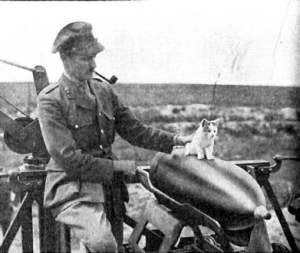 War kitten, WWIIPresident Roosevelt issued a military order establishing the Office of Strategic Services (OSS) in 1942 to act as an umbrella agency for intelligence activities. In World War II, the OSS drew up a lengthy plan using cats to bomb enemy ships. No one outside of the OSS knows just how much money was spent on the project. The theory was based on cats hating water and their ability to land on their feet. Cats have a unique skeletal system and no collarbone, so they can twist themselves around to land – but they don’t make it every time, and usually only from short distances. The OSS finally laid out a master plan: The cats would be wired to an explosive. U.S. planes flying over enemy ships would drop the cats near the ships. The cats would scramble in the air to land on the closest dry spot – the deck of the enemy plane. Or, they would fall in the ocean and frantically swim to the nearest dry place: ideally, the enemy ship. Exactly how the cats were going to direct themselves towards an enemy ship remained in question. The project made it to the testing phase but went defunct because when the airplanes dumped the unfortunate felines into the water, it rendered the cats unconscious. The project sank. The OSS was closed in 1945. A new organization took its place, the Central Intelligence Group (CIG). The National Security Act of 1947 turned CIG into the CIA (Central Intelligence Agency). The name had changed, but the idea of using cats in wartime remained. In the 1960s, there was a popular Hot Springs, Arkansas tourist attraction called “The IQ Zoo.” Animals were trained to perform various tricks, including pigs “playing” the piano.The IQ Zoo also assisting in training animals, including cats, to be cold war spies. There were several
War kitten, WWIIPresident Roosevelt issued a military order establishing the Office of Strategic Services (OSS) in 1942 to act as an umbrella agency for intelligence activities. In World War II, the OSS drew up a lengthy plan using cats to bomb enemy ships. No one outside of the OSS knows just how much money was spent on the project. The theory was based on cats hating water and their ability to land on their feet. Cats have a unique skeletal system and no collarbone, so they can twist themselves around to land – but they don’t make it every time, and usually only from short distances. The OSS finally laid out a master plan: The cats would be wired to an explosive. U.S. planes flying over enemy ships would drop the cats near the ships. The cats would scramble in the air to land on the closest dry spot – the deck of the enemy plane. Or, they would fall in the ocean and frantically swim to the nearest dry place: ideally, the enemy ship. Exactly how the cats were going to direct themselves towards an enemy ship remained in question. The project made it to the testing phase but went defunct because when the airplanes dumped the unfortunate felines into the water, it rendered the cats unconscious. The project sank. The OSS was closed in 1945. A new organization took its place, the Central Intelligence Group (CIG). The National Security Act of 1947 turned CIG into the CIA (Central Intelligence Agency). The name had changed, but the idea of using cats in wartime remained. In the 1960s, there was a popular Hot Springs, Arkansas tourist attraction called “The IQ Zoo.” Animals were trained to perform various tricks, including pigs “playing” the piano.The IQ Zoo also assisting in training animals, including cats, to be cold war spies. There were several
 “Operation Acoustic Kitty”reasons why cats were still considered ideal for covert operations. Cats fit into tight spaces (cats use their whiskers as a measuring device.). Cats can walk around unnoticed, more so than a stray dog. They are challenging to catch and hold. Thus over five years, the CIA developed “Operation Acoustic Kitty” at the cost of about $20 million. A California otolaryngologist who assisted in the invention of the cochlear implant worked with the CIA Science & Technology Department team; they were turning cats into walking transmitters. A microphone was placed in the cat’s ear canal. Fine wires of the antenna were woven into the cat’s fur to the tail tip. A wire ran from inside the cat’s skull to an instrument cluster and battery sewn inside the rib cage. The team would train the cat to move using ultrasonic sound. One rumor has the premier test cat released from an undercover van; the cat sashaying across the street to be promptly run over by a taxi; according to some operatives, this is just a nasty, anti-CIA, anti-spy cat rumor. The program was as short-lived as the test cat. Operation “Acoustic Kitty” was shut down in 1967 and deemed another “spy cat” failure. The CIA has an expression used throughout the organization when a plan goes awry. “The idea is to go back to its beginning and then walk through the plan again to spot where it went off-target.” The expression is “Walking the cat” (King, 2011, p.119).
“Operation Acoustic Kitty”reasons why cats were still considered ideal for covert operations. Cats fit into tight spaces (cats use their whiskers as a measuring device.). Cats can walk around unnoticed, more so than a stray dog. They are challenging to catch and hold. Thus over five years, the CIA developed “Operation Acoustic Kitty” at the cost of about $20 million. A California otolaryngologist who assisted in the invention of the cochlear implant worked with the CIA Science & Technology Department team; they were turning cats into walking transmitters. A microphone was placed in the cat’s ear canal. Fine wires of the antenna were woven into the cat’s fur to the tail tip. A wire ran from inside the cat’s skull to an instrument cluster and battery sewn inside the rib cage. The team would train the cat to move using ultrasonic sound. One rumor has the premier test cat released from an undercover van; the cat sashaying across the street to be promptly run over by a taxi; according to some operatives, this is just a nasty, anti-CIA, anti-spy cat rumor. The program was as short-lived as the test cat. Operation “Acoustic Kitty” was shut down in 1967 and deemed another “spy cat” failure. The CIA has an expression used throughout the organization when a plan goes awry. “The idea is to go back to its beginning and then walk through the plan again to spot where it went off-target.” The expression is “Walking the cat” (King, 2011, p.119).Resources
American Pet Product Association, 2019-2020. Pet Industry Market Size & Ownership Statistics. Stanford: American Pet Product Association. Cia.gov. 2020. Acknowledgments — Central Intelligence Agency. [online] Available at: <https://www.cia.gov/library/publicati... [Accessed 22 May 2020].Harris, R. & Paxman, J. (2007). A Higher Form of Killing: The Secret History of Chemical and Biological Warfare. New York: Random House.
How Many Stray Cats in America? Professional Wildlife Removal. http://www.wildlife-removal.com/howma...
King, B. (2011). Big Book of Spy Stuff. Utah: Gibbs-Smith.
Mark, J. J. (2017, June 13). The Battle of Pelusium: A Victory Decided by Cats. Ancient History Encyclopedia. Retrieved from https://www.ancient.eu/article/43/ [Accessed 22 May 2020].
Photo creditsCat in WWII: Original unknown, retrieved from http://www.cynical-c.com/2007/06/18/7... “Operation Acoustic Kitty”: Unknown
May 8, 2020
Cayetano Santos Godino, Argentina’s first serial killer, began crimes at 7
Of the 600 inmates in Ushuaia Prison in Ushuaia, Tierra del Fuego, Argentina, there was now one less housed in the 380 cells. The officer’s boots echoed off the stone floor as they came running, the heavy wooden cell door creaking open to reveal inmate Cayetano Santos Godino lying dead in his cell. It was November 15, 1944. Inmates and staff alike probably were uttering “Good riddance,” throughout the prison. Godino was a pyromaniac, animal and child abuser, and considered Argentina’s first serial killer. “El Petiso Orejudo” (“The Big-Eared Midget”) was dead, and Buenos Aires could breathe a collective sigh of relief. This horrific chapter in criminal history was over.Cayetano Santos Godino was Buenos Aires’ native son, born 1896 into an Italian immigrant family of eight boys and abusive alcoholic parents. The family was destitute. Santos, as he was known, suffered poor health due to his father’s syphilis. From the moment he was old enough to step into a school classroom, documentation began, revealing how Santos started exhibiting some early warning signs of predatory and homicidal behavior. Santos bounced from school to school. No one – teachers, staff, and his parents – could manage his behavior, his total disinterest in education. So he wandered the streets, escaping the doldrums of school and the poverty and abuse at home. The boy was torturing and killing small animals, cats and birds; his father found dead birds in his son’s shoes and under the boy’s bed. Santos began setting fires whenever he could lay hands on a match. Furthermore, he was a mean little boy. Not just a bully, but frightfully mean.
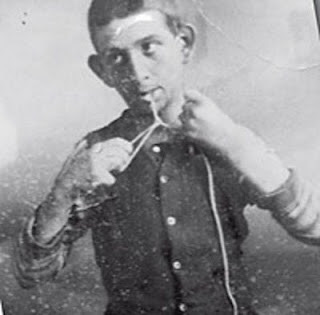 Cayetano Santos Godino demonstrating to
Cayetano Santos Godino demonstrating to police how he tied knots to bind his victimA seven-year-old Santos severely beat a two-year-old boy and was tossing the body into a ditch of thorny bushes when a witness caught them; they were both taken to a police station, where dutiful parents picked them up. By now, Santos’ family was privy to his behavior. Not even police intervention helped because at eight years old, officers stopped Santos from pounding rocks into the body of a little girl, a much younger child. Again, because of his age, the family was called, and Santos went home. Santos did not stop; he was holding a lit cigarette to the eyelids of a two-year-old when the baby’s mother heard the screams of anguish and came running; Santos escaped. Then Santos was arrested when trying to drown a two-year-old in a horse trough. Again, his age prevented him from being kept behind bars. Santos finally did spend time behind bars. His parents, always catching him masturbating, turned him over to the cops. Masturbation was an illegal act: “Offending good manners with impudent exhibitions, obscene acts or gestures, attentive to modesty, practiced in public or attended by the public, and which, without offense to individual honesty, insult and scandalize society” (Article 282, Penal Code of the United States of Brazil, October 11, 1890). Booking photos were taken of the nude boy, from front and side. Santos was ten.Santos’ parents would retrieve him and, hoping that the juvenile institution had reformed him, announced they had found him a factory job. It lasted a few months. Santos took to the streets, now fueled by alcohol, picking up where he left off. A 13-year-old naked child’s corpse was found in an abandoned house in 1912. The victim, severely beaten, had a rope tied around the throat. It remains a cold case. Santos is suspected. Santos’ love affair with fire never ended. Something about the red and yellow flames licking and shooting into the air fascinated him. While his fascination led to charges of arson it also resulted in one known death. In March 1912, a five-year-old girl died as the result of the burns she suffered when Santos purposely set fire to her dress. He tried to burn down a train station but the flames were extinguished before much damage was done, much to his chagrin. In January 1912 at the age of sixteen, he was arrested for burning down a warehouse. “I like to see firemen working,” he admitted to the arresting officers. “It’s nice to see how they fall into the fire” (Cabezas). There were two more fires in late September, and both extinguished before severe damage could be done. In between fiery endeavors, there was murder.Cayetano Santos Godino’s first arrest for attempted murder was on November 8, 1912. He was caught trying to choke an eight-year-old boy to death. Santos was released and awaiting trial when he was again caught beating a child, this time a three-year-old, eight days later. On the 20th, a neighbor stopped Santos from kidnapping a two-year-old girl. As November 1912 turned to December, Santos was spending his last days of freedom. Jesualdo Giordano was not yet two when Santos found him playing outside the Giordano home. Santos offered the baby some candy, and little Jesualdo happily obliged. Using the temptation of more candy, Santos led the little one to an empty building away from the area. Once inside, Santos shoved the baby to the floor and tried unsuccessfully to choke him with Santos’ belt. He then used the belt to bind Jesualdo’s limbs. That’s when the beating began. Later, he would admit it was at this time he began thinking of driving a nail into the boy’s skull.Santos left the crumbling building to find a nail, and instead found Mr. Giordano. “I can’t find Jesualdo!” The panicked father told Santos. “Have you seen him!” To which a cool Santos replied in the negative. Santos returned to the crime scene with a nail and brick to hammer it into Jesualdo Giordano’s skull. Satisfied, he tried to hide the dead body and departed. However, Mr. Giordano had not given up his
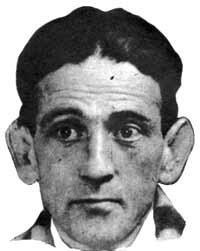 Cayetano Santos Godino
Cayetano Santos Godino mug shot in Ushuaia Prisonsearch and the father located the son in less than fifteen minutes.A wake was held in the family home per tradition, the body on display. Cayetano Santos Godino attended, touching the hole where the nail had been imbedded in the corpse. Santos was arrested the following day and readily admitted to the horrific crime. He also admitted to something else: when he was ten, Santos had abducted “Maria Rosa Face, only three, whom he tried to strangle and then not succeeding he buried her alive on March 29, 1906” (Lilith).He earned the moniker “El Petiso Orejudo” (“The Big-Eared Midget”) due to his protruding ears and small stature. He was declared “mentally disabled … unaware of his actions” and sent to a mental health facility (“asylum”) in January 1913. He was interviewed by doctors and declared legally insane (Lots of Breeze).“The Big-Eared Midget” proved he could not stay out of trouble, even in a reformatory. He picked up an attempted murder charge when he tried killing fellow patients. Still, a judge ruled Santos was unable to understand his actions. The Chamber of Appeals overturned the ruling in 1915 and sentenced Cayetano Santos Godino to life in prison. In March of 1923, the courts had Santos transferred to Ushuaia Prison. Still, Santos’ bloodlust and penchant for fire were unabated. The inmates kept two pet cats behind bars, taking care of the animals, feeding, and caring for the cats. The felines were considered mascots of sorts. In 1933 Santos beat the cats to death and tossed the carcasses into a fire. His fellow inmates were outraged, and this time Santos was locked in with at least 599 disgusted individuals seeking revenge. Officers found Santos beaten close to death. Most of 1933 found Santos in the prison hospital, and once released, he remained ill. His death in 1944 was considered “mysterious circumstances” (possibly a long-lasting result of the beating inmates gave him) but legally listed as internal bleeding due to gastritis.
Resources
Cabezas López, Carlos (September 16, 2007). "Cayetano Santos Godino, la historia del Petiso Orejudo". Caso Abierto (in Spanish). Archived from the original on August 1, 2008. Retrieved through https://en.wikipedia.org/wiki/Cayetan... on May 8, 2020.
Cayetano Santos Godino: the first serial killer in Argentina. (April 10, 2017). Lots of Breeze. Mutabrisa. https://muitabrisa.com.br/cayetano-sa....
Lilith. (September 30, 2015). Cayetano Santos Godino – the child who killed children. Emadion. https://emadion.it/en/homicides/seria...
"Penal Code of the United States of Brazil". Article 282, Decree No. 847 of 11 October 1890.
Santos child photo is public domain
Santos mug shot courtesy: Public Domain, https://commons.wikimedia.org/w/index...
Serial killer “big-eared midget” dies in prison cell.” (November 15, 2017) Horror History. https://horrorhistory.net/2017/11/15/...
Ushuaia Prison, World Monuments Fund. https://www.wmf.org/project/ushuaia-p...
April 29, 2020
The Hungerford Massacre - Gunman Strolls Around Town Murdering Innocents
 One of the few public images of
One of the few public images ofshooter Michael Ryan He is growing up now. Never marries and childless, living with both parents until his father dies. Michael has a penchant for anything military. His room is resembling an army barracks, with face paint, camo clothing, knives, bullets, bulletproof vests, and guns, always guns. He holds membership cards for two gun clubs. Soon the arsenal includes a Norinco Type 56S; an assault rifle patterned off the Kalashnikov; there is a Beretta 92FS and an M1 Carbine. The latter has magazines that can hold up to 30 rounds. To own these guns, a civilian must have an officer of the law sign off on legal paperwork. A PC Wainright signs Michael’s firearms certificates.Michael makes up stories of grandiosity. He is engaged to a beautiful woman. There is a high-ranking military official who has taken an interest in Michael and is going to help Michael’s career, who claims he is now a parachute trooper. Michael’s mother plays along. She invites people to the wedding. She brags about her son’s future career. When his father dies, Michael and his mother sell the family home to move in together, a house on Southview Street, remaining in Hungerford. Michael spends time between home and two gun clubs. His mother continues to purchase whatever he points at, voicing a desire for what will make him happy. Michael Ryan is such an excellent shot that trophies and ribbons are part of his room’s décor. And he has another hobby, this one secret. Ten miles from Hungerford is a beautiful wooded park, Savernake Forrest. It’s perfect for dressing in full camouflage, duck, and dive to follow unsuspecting people. Test your military skills. See how close you can get to them, watching the people. Sexual fantasies probably began to build for a man who has no social life. It’s a powerful feeling to creep upon ladies, smell and hear them, and slip away. He can reach over to touch them, more maybe. And they not even know he is there.August 19, 1987, at noon Michael feels it’s time to act. He is wearing his military gear and carries a gun. Sue Godfrey, thirty, has pulled her car into a parking area and removed her two children from their car seats for a picnic in Savernake Forrest. Michael approaches. He orders her to strap the babies back into their car seats. He takes Sue into the forest. Soon after, the babies found wandering, hand in hand. Their mommy, one foot tangled over a low-lying wire fence, her body riddled with bullets. By then, everyone is sure who is responsible.Michael is spooked. He races to his vehicle, drives away from Savernake Forrest to stop at a gas station, a regular stop. He fills his car and a gas can, then heads to the attendant’s booth. There is a motorcyclist who has stopped to gas his tank, then kicks his bike into gear to pull out. Only then, Michael chambers a round into his rifle, and the glass in the booth explodes. The female attendant now dives for cover. She is cowering as the rifle’s front site hovers over her body. A clicking noise tells her the rifle jams. Frightened again, Michael runs. The motorcyclist has not departed. Michael works the chamber and takes a shot at the motorcyclist who roars off to dial 999 (the United States’ 9-1-1). It will be the first 999 to flood the emergency service hotline and later lead to much-needed changes in an entire system. For now, it will be another call clogging a taxed system.At 12:45, Michael arrives at his home on Southview Street. He runs in to gather up precious guns, ammo, and don a bulletproof vest. He puts a bullet in the family dog. Then he upturns the gas can. Photographs, furniture, mementos, his boyhood collections, dishes, towels, clothing - in seconds, it is all a roaring furnace.He leaps into the car and on his way to freedom … until the car doesn’t start. The engine whines. A turn of the key, a stomp of the foot pedals. This is the catalyst. No turning back now, because there is no escape. There is no beautiful girl, no fabulous wedding, and no high-ranking military official. Just a lonely man who will never fit in and everyone around reminds him of that. So he gets out and blisters the car full of bullet holes, then sets off for the only destiny he can fathom that will make him a real man.The first few shots and two neighbors fall dead in their yard, a married couple that has known Michael since he was a two-year-old. They never knew what happened. Next, random fire into a group of school-aged children. Up and down Southview. Some people walk into the gunfire unknowingly. Some dive for cover. Others just stop to stare in disbelief. This is Hungerford, a nonviolent little hamlet. What is shy, Michael Ryan doing? Michael has the Norinco Type 56S, the Beretta 92FS, and his M1 Carbine. There are full magazines stuffed in his pockets and waistband. He drops some of the magazines, not bothering to retrieve them. 999 calls begin. The system needs updating, and there are only two lines. Initially, the officers answering the calls are polite, then stern. They hang up on callers. The closest ambulance and fire truck, even the police and Tactical Firearm Squad are an hour away. “Man shooting!” “A woman has been shot!” “My little girl is bleeding!” “A man is lying in the street!” And on. Then she comes home. Michael’s mama, the only person he loves and trusts. People shout at her to stop driving, turn, stop, Michael’s gone mad! She ignores them all, drives towards her burning home. Witnesses see Mrs. Ryan get out of her car. She approaches her son. “Michael, stop it!” They converse in low tones. “No!” She orders him. “Don’t shoot me.” He raises the Beretta 92FS handgun. Bam. Bam. She falls dead at his feet. He pumps two more bullets into her back. Bam. Bam. And off he goes.Finally, responding officer PC Brereton pulls up. He is calling for backup. This is no “shots fired,” as reported. This is a bloodbath. Michael casually circles the squad car and pumps two -dozen rounds into the vehicle. PC Brereton dies with the two-way radio mic in his clenched hand. Kicking down the door into a house. Shots echo from inside. Michael walks out just as calmly as he walked in. Three people are dead, including a married couple. The man has thrown himself over his wife, who uses a wheelchair, to protect her. He is circling Southview Street. Some of the targeted neighbors dodge the bullets. Others are only wounded, helplessly watching their blood pool. A taxi pulls up, and Michael pops off 5-6 rounds into the car, killing two. His expression does not change until now. He drops the Norinco Type 56S; his face now registers shock as if just awoke from a deep sleep and realizes what he has done. Has it stopped here?Michael Ryan picks up the rifle. His face returns to the bland expression, his eyes dead again. And people begin to die in their tracks. PC Wainright is from Hungerford and remains a resident. He is on his way, responding to the incident. He learns his good friend and fellow officer PC Breretonis is dead; this is serious. It’s Market Day in Hungerford, and the town center is busy. At the same time, unbeknownst to him, his parents are driving towards his house for a surprise visit. PC Wainright’s parents have stopped in the street because an armed man is standing in the center of the road. The man raises his rifle and kills PC Wainright’s father, who slumps behind the wheel. When his mother steps out of the car, he raises his gun to shoot her down. PC Wainright will sign his own father’s death certificate. By now, first responders arrive, and the Tactical Firearm Squad huddles up to discuss strategy. The police helicopter was out on repair, so it is late arriving, now it hovers overhead but not too close. Michael’s Norinco Type 56S assault rifle, initially mistaken for the Kalashnikov, can penetrate a brick wall from half a mile away; it can take down a chopper. And no one knows where the shooter is now. There are bodies, pools of blood, scattered magazines, and bullet jackets everywhere. The sniper from the Tactical Firearm Squad doesn’t have his rifle; it’s locked up back at the station. The Squad was at training when they were called to the scene. Michael does not kill everyone he sees. To some, he holds a finger to pursed lips, “Shh.” To others, he lifts his rifle and says, “bang!” He does not turn towards downtown and the Market Day crowd. He turns toward the John O’Gaunt School, where he spent many hours in its hallways and classrooms as a lad.It is 1:57. Michael has left sixteen people dead and as many seriously wounded. Police find him at the school, and they surround the building. They have no idea of the school floor plan. Michael has the advantage. Then Michael shatters a lower window to throw a rifle out with a white “surrender” flag attached. Police outside begin a dialogue with Michael, crunched into a corner of a classroom. Michael continually asks about his mother. “Is she alright?” He assures them he did not mean to shoot her. “Will she be alright?”He tells police he did not plan the spree. “Hungerford must be a mess,” he says. Then, “This would have never happened if my car would have started.”One officer gets a look at Michael’s face. “He looked lost” the cop would later explain.“Strange,” Michael calls out the window. “I killed all those people, but I don’t have the guts to blow my own brains out.”The officer assures Michael, no one else has to die. No one wants Michael to die. They want to help
 The press attempted to find answers: what
The press attempted to find answers: what made Michael Ryan commit his crime? him. Please, Mr. Ryan. Just come on out, hands up. Then, “What time is it?”“It’s-” The officer checked his wristwatch – “Six forty-five. Why do you want to know what time it is, Mr. Ryan?”The gunshot explosion answered. Michael Robert Ryan found “the guts.” At 27, he is dead by suicide, now bringing the death toll to 17. The single bullet would be one of 84 recovered rounds. As a result of what England calls “The Hungerford Massacre,” the 999 system receives a complete makeover. The Firearms (Amendment) Act 1988 is passed by The Parliament of the United Kingdom, banning the ownership of semi-automatic center-fire rifles (and) restricting shotguns with a capacity of more than three cartridges. Until 1996, the Hungerford Massacre was the worst firearms-related crime in The United Kingdom. Some Hungerford residents were unkind to PC Wainright, blaming him for the massacre because he signed off on Michael Ryan’s firearms certificates. Other residents rallied around PC Wainright. He buried his good friend, both parents, and neighbors, lived with the guilt that he signed those certificates, and he continued to live in Hungerford. And no one knew why Michael Robert Ryan went on a shooting spree that August 19, 1987. Psychiatrists tried to diagnose him. Sociologists made an effort. Friends and neighbors attempted to dredge up a memory that might explain. The two people that might have a substantial clue are gone. Michael is cremated. His mother is buried. So are the answers.
April 22, 2020
The Story of Kane: A Dog Wrapped In Legal Red Tape
Some dogs are more than “just a dog;” they are family. There are more photos of the dog than people on family’s social media: there is a celebration for the pup’s milestones, and there are monikers like “My Baby” or “My Little Man.” Such is the case with Kane, a white English bulldog. From six weeks old, when he arrived at his family’s home in 2013, Kane celebrated holidays, surrounded by adoration, continually having his picture taken. The family’s four-year-old daughter dressed Kane and painted his nails for tea parties he dutifully attended. He accompanied the family teen on fishing expeditions. Outside, the beloved pup stayed close to the house, snuffling the wild grasses, a happy, free, and healthy dog. Then Kane went missing around 5:00 p.m. on Sunday, March 22, 2020.
 Kane's first day home
Kane’s family, Police Officer Lesley Dyan, and her husband State Trooper Adam, immediately began to call for Kane. They live in a rural area, so they were hiking pastures and driving door to door to speak to neighbors while searching under trees and bushes. Leslie and Adam were asking everyone, “Have you seen Kane, our white English Bulldog?” English bulldogs, by nature, prefer to snooze on the couch than chase squirrels. If they decide to explore, they rarely go far. The family kept the search close to home.Leslie, in particular, was frantic. Kane was her “baby,” her confidant who helped her get through rough patches in life. His soft, white fur caught many of her tears, and kisses during joyous times; Kane was as close to her heart as a patrol partner or a spouse.Kane’s family lives on a dead-end road, amid four houses. One of those houses belongs to a man named Heatherly. At the time of Kane’s disappearance and into the evening, Heatherly never answered his door when Kane’s family was knocking; his truck parked in his driveway. They heard a dog barking from inside the Heatherly home. “He has two other dogs, a Lab(rador retriever) and a little mixed terrier,” Leslie says. So a dog’s frantic barking did not seem unusual.Kane’s family continued to canvas the neighborhood, climbing bluffs through thickets and asking permission to search the neighbor’s properties.Monday night, Lesley and Adam again spoke with their neighbors, hoping for good news. They were still unsuccessful in speaking with Heatherly; his truck was unmoved, and he never answered his door despite their repeated efforts. Inside his home, a dog continued to bark frantically.On Heatherly’s Facebook, he poses with a Labrador retriever; there is a photo of this dog with a smaller, mix-breed dog. Tuesday, March 24 at 7:55 a.m., Heatherly posted on his Facebook account,
Kane's first day home
Kane’s family, Police Officer Lesley Dyan, and her husband State Trooper Adam, immediately began to call for Kane. They live in a rural area, so they were hiking pastures and driving door to door to speak to neighbors while searching under trees and bushes. Leslie and Adam were asking everyone, “Have you seen Kane, our white English Bulldog?” English bulldogs, by nature, prefer to snooze on the couch than chase squirrels. If they decide to explore, they rarely go far. The family kept the search close to home.Leslie, in particular, was frantic. Kane was her “baby,” her confidant who helped her get through rough patches in life. His soft, white fur caught many of her tears, and kisses during joyous times; Kane was as close to her heart as a patrol partner or a spouse.Kane’s family lives on a dead-end road, amid four houses. One of those houses belongs to a man named Heatherly. At the time of Kane’s disappearance and into the evening, Heatherly never answered his door when Kane’s family was knocking; his truck parked in his driveway. They heard a dog barking from inside the Heatherly home. “He has two other dogs, a Lab(rador retriever) and a little mixed terrier,” Leslie says. So a dog’s frantic barking did not seem unusual.Kane’s family continued to canvas the neighborhood, climbing bluffs through thickets and asking permission to search the neighbor’s properties.Monday night, Lesley and Adam again spoke with their neighbors, hoping for good news. They were still unsuccessful in speaking with Heatherly; his truck was unmoved, and he never answered his door despite their repeated efforts. Inside his home, a dog continued to bark frantically.On Heatherly’s Facebook, he poses with a Labrador retriever; there is a photo of this dog with a smaller, mix-breed dog. Tuesday, March 24 at 7:55 a.m., Heatherly posted on his Facebook account,
Lesley and Adam were not connected to Heatherly on social media.Searching the area was now a ritual. Lesley Dyan, Adam Marsh, and their children searched for miles screaming for Kane until their throats were raw, hearts pounding, tears streaming down chapped faces. Would they turn a corner and see their sweet, goofy boy sitting there? Or find him…?It was Sunday, March 29, on another round of searching for her “little man” that Lesley says they again observed Heatherly’s truck parked in his driveway, unmoved. She and her husband drove into Heatherly’s yard, this time noting a strange smell emanating from the house; after eighteen years as a police officer, Lesley knows the smell of death, and she became frantic when it reached her nostrils. “What if (Heatherly’s) dead?” She asked Adam. “We haven’t seen him all week, and his truck hasn’t moved!” Concerned, they hurried to pound on the door. “I was frantic,” she recalls. The thought of a neighbor dying alone was horrific. She wondered if, in a desperate attempt, he had tried to contact any one of them…?This time Heatherly answered the door, and as Lesley exhaled in relief, Adam was asking, “Hello sir, just wanted to check on you. And we also wanted to ask, have you seen a little white bulldog? We’ve been looking for him all week.”Lesley Dyan has experienced some horrific things in her career and handled many sad cases. When tragedy hits home, the feeling of helplessness just doubles. So Heatherly’s flippant response was initially surreal.“Yeah,” Heatherly answered Adam’s question. “He’s been in here in the living room dead, about four days.”
 Kane's last Christmas
Forgetting protocol, Adam jerked the door open and pushed his way inside the house. Lesley recalls they observed boxes piled haphazardly to the ceiling as Adam weaved around piles of garbage and empty beer cans where maggots tumbled. Adam, a trained crime scene investigator observed the area where Kane’s dead body had laid and the trail where Kane had been drug to where Adam now found his little family member, on the back porch, a rotting corpse.“What did you do!” Adam now demanded.Heatherly reportedly told the story. “I fed him and put him in the house.”“Did you even let him outside?”“No. I didn’t want him to run off because I was so excited about having an English bulldog.” He began hesitating. “I went to sleep, and the next morning I woke up and he was dead. He’s been laying there for about four days now.”“Why didn’t you just let him out so he could come home to his family!” Adam, a big, strong state trooper, was now close to tears.“I… just didn’t want him to run off.”“But - he could have just gone home to his family…”Heatherly shrugged. “I didn’t want him to run away.” He did admit he allowed Kane to go outside once, on a lead, to relieve himself.English bulldogs, no matter how well-bred, have medical issues. Stomach, eyes, bones, and skin problems are not uncommon. The females must be inseminated and give birth by cesarean. Many bulldogs require specialized food and daily medication. Because of the debris in the house, Kane may have fed on something dangerous to his already delicate system. It is possible that Heatherly’s dog did attack and fatally harm Kane. Or perhaps something in the home fell on him, killing him.The cause of Kane’s demise will never be known; a representative of Cullman County Animal Control explains, “the state of necropsy was so advanced that an autopsy would have been difficult, if not impossible, to perform.”Lesley says, “The investigator from the Sheriff’s Department who later went to (Heatherly’s) house interviewed (Heatherly) and he lied to them. The investigator did his best to help us.” But it seems to Lesley the reports and photographs taken from two career law enforcement officers have no bearing because on April 1 the District Attorney’s office telephoned Lesley to explain there would be no legal action taken. Kane’s case was closed.[1]“Bullies” are an expensive breed to own. Their purchase price ranges between $1500 – 10,000. Anyone charged with theft
Kane's last Christmas
Forgetting protocol, Adam jerked the door open and pushed his way inside the house. Lesley recalls they observed boxes piled haphazardly to the ceiling as Adam weaved around piles of garbage and empty beer cans where maggots tumbled. Adam, a trained crime scene investigator observed the area where Kane’s dead body had laid and the trail where Kane had been drug to where Adam now found his little family member, on the back porch, a rotting corpse.“What did you do!” Adam now demanded.Heatherly reportedly told the story. “I fed him and put him in the house.”“Did you even let him outside?”“No. I didn’t want him to run off because I was so excited about having an English bulldog.” He began hesitating. “I went to sleep, and the next morning I woke up and he was dead. He’s been laying there for about four days now.”“Why didn’t you just let him out so he could come home to his family!” Adam, a big, strong state trooper, was now close to tears.“I… just didn’t want him to run off.”“But - he could have just gone home to his family…”Heatherly shrugged. “I didn’t want him to run away.” He did admit he allowed Kane to go outside once, on a lead, to relieve himself.English bulldogs, no matter how well-bred, have medical issues. Stomach, eyes, bones, and skin problems are not uncommon. The females must be inseminated and give birth by cesarean. Many bulldogs require specialized food and daily medication. Because of the debris in the house, Kane may have fed on something dangerous to his already delicate system. It is possible that Heatherly’s dog did attack and fatally harm Kane. Or perhaps something in the home fell on him, killing him.The cause of Kane’s demise will never be known; a representative of Cullman County Animal Control explains, “the state of necropsy was so advanced that an autopsy would have been difficult, if not impossible, to perform.”Lesley says, “The investigator from the Sheriff’s Department who later went to (Heatherly’s) house interviewed (Heatherly) and he lied to them. The investigator did his best to help us.” But it seems to Lesley the reports and photographs taken from two career law enforcement officers have no bearing because on April 1 the District Attorney’s office telephoned Lesley to explain there would be no legal action taken. Kane’s case was closed.[1]“Bullies” are an expensive breed to own. Their purchase price ranges between $1500 – 10,000. Anyone charged with theft
 Kane
of such a dog can be charged with felony theft. But the charge was denied in this case (by the District Attorney’s office) “because Heatherly said Kane walked up on his back porch,” says Lesley. During an interview, Heatherly says that Kane showed up at his house “the day before he died.” He says he doesn’t recall the day or date that Kane came to his door. And when asked for more information, Heatherly has not responded, despite numerous attempts to speak with him.Adam has photographs of the evidence but refuses to allow Lesley to see Kane in that state. Kane is buried in the backyard where he once snuffled the wild grasses, where he was once a happy, free, and healthy family member.Lesley Dyan is aghast at a system that does not protect animals and, in her opinion, fails to respect the words of two dedicated career officers. “A crime was committed, two law enforcement officers saw the evidence and heard the statement this individual made when the incident unfolded.”Lesley looks over photographs of her “sweet little man” Kane, from the day he came home and fit in the crook of her arm to his last Christmas when he tolerated a whimsical hat for a photograph. The tears and heartache never stop. The pain is almost intolerable, as only an animal lover knows. Grief from losing Kane is searing because of how Kane was lost: to what appears to be both a heartless, cruel death and a system that cares nothing for creatures. “I want readers to know that our legal systems are still not taking animal cruelty seriously. The ones who hurt our animals are killers, plain and simple.”
Kane
of such a dog can be charged with felony theft. But the charge was denied in this case (by the District Attorney’s office) “because Heatherly said Kane walked up on his back porch,” says Lesley. During an interview, Heatherly says that Kane showed up at his house “the day before he died.” He says he doesn’t recall the day or date that Kane came to his door. And when asked for more information, Heatherly has not responded, despite numerous attempts to speak with him.Adam has photographs of the evidence but refuses to allow Lesley to see Kane in that state. Kane is buried in the backyard where he once snuffled the wild grasses, where he was once a happy, free, and healthy family member.Lesley Dyan is aghast at a system that does not protect animals and, in her opinion, fails to respect the words of two dedicated career officers. “A crime was committed, two law enforcement officers saw the evidence and heard the statement this individual made when the incident unfolded.”Lesley looks over photographs of her “sweet little man” Kane, from the day he came home and fit in the crook of her arm to his last Christmas when he tolerated a whimsical hat for a photograph. The tears and heartache never stop. The pain is almost intolerable, as only an animal lover knows. Grief from losing Kane is searing because of how Kane was lost: to what appears to be both a heartless, cruel death and a system that cares nothing for creatures. “I want readers to know that our legal systems are still not taking animal cruelty seriously. The ones who hurt our animals are killers, plain and simple.”[1] An attempt to contact the Sheriff’s office resulted in no response
How can you help toughen animal rights laws? See your state's animal rights laws - click hereLearn how laws are changed and created - easy reference guide - click here
(All photos of Kane courtesy L. Dylan)



